RD Sharma Solutions Class 10 Maths Chapter 6 – Free PDF Download
RD Sharma Solutions for Class 10 Maths Chapter 6 – Trigonometric Identities are provided here. The branch of Mathematics which deals with the measurement of the sides and the angles of a triangle is known as trigonometry. Students who find it difficult to understand the concepts covered in this chapter can make their learning process smooth and easy using RD Sharma Solutions. These solutions are well structured by our subject expert team at BYJU’S to help students grasp the in-depth knowledge of concepts which are vital for examinations.
Trigonometric Identities is the 6th Chapter of RD Sharma Solutions Class 10. This chapter consists of two exercises. Students can find the precise answers for these exercises in RD Sharma Solutions for Class 10. The previous chapter was about trigonometric ratios and the relations between them. But this chapter explains the trigonometric identities in a comprehensive manner in accordance with the student’s intelligence quotient.
RD Sharma Solutions for Class 10 Maths Chapter 6 Trigonometric Identities Here
Access the RD Sharma Solutions for Class 10 Maths Chapter 6 – Trigonometric Identities
RD Sharma Solutions for Class 10 Maths Chapter 6 Exercise 6.1 Page No: 6.43
Prove the following trigonometric identities:
1. (1 – cos2 A) cosec2 A = 1
Solution:
Taking the L.H.S.,
(1 – cos2 A) cosec2 A
= (sin2 A) cosec2 A [∵ sin2 A + cos2 A = 1 ⇒1 – sin2 A = cos2 A]
= 12
= 1 = R.H.S.
– Hence, proved.
2. (1 + cot2 A) sin2 A = 1
Solution:
By using the identity,
cosec2 A – cot2 A = 1 ⇒ cosec2 A = cot2 A + 1
Taking,
L.H.S. = (1 + cot2 A) sin2 A
= cosec2 A sin2 A
= (cosec A sin A)2
= ((1/sin A) × sin A)2
= (1)2
= 1
= R.H.S.
– Hence, proved.
3. tan2 θ cos2 θ = 1 − cos2 θ
Solution:
We know that,
sin2 θ + cos2 θ = 1
Taking,
L.H.S. = tan2 θ cos2 θ
= (tan θ × cos θ)2
= (sin θ)2
= sin2 θ
= 1 – cos2 θ
= R.H.S.
– Hence, proved.
4. cosec θ √(1 – cos2 θ) = 1
Solution:
Using identity,
sin2 θ + cos2 θ = 1 ⇒ sin2 θ = 1 – cos2 θ
Taking L.H.S.,
L.H.S = cosec θ √(1 – cos2 θ)
= cosec θ √( sin2 θ)
= cosec θ x sin θ
= 1
= R.H.S.
– Hence, proved.
5. (sec2 θ − 1)(cosec2 θ − 1) = 1
Solution:
Using identities,
(sec2 θ − tan2 θ) = 1 and (cosec2 θ − cot2 θ) = 1
We have,
L.H.S. = (sec2 θ – 1)(cosec2θ – 1)
= tan2θ × cot2θ
= (tan θ × cot θ)2
= (tan θ × 1/tan θ)2
= 12
= 1
= R.H.S.
– Hence, proved.
6. tan θ + 1/ tan θ = sec θ cosec θ
Solution:
We have,
L.H.S. = tan θ + 1/ tan θ
= (tan2 θ + 1)/ tan θ
= sec2 θ / tan θ [∵ sec2 θ − tan2 θ = 1]
= (1/cos2 θ) x 1/ (sin θ/cos θ) [∵ tan θ = sin θ / cos θ]
= cos θ/ (sin θ x cos2 θ)
= 1/ cos θ x 1/ sin θ
= sec θ x cosec θ
= sec θ cosec θ
= R.H.S.
– Hence, proved.
7. cos θ/ (1 – sin θ) = (1 + sin θ)/ cos θ
Solution:
We know that,
sin2 θ + cos2 θ = 1
So, by multiplying both the numerator and the denominator by (1+ sin θ), we get

L.H.S. = R.H.S.
– Hence, proved.
8. cos θ/ (1 + sin θ) = (1 – sin θ)/ cos θ
Solution:
We know that,
sin2 θ + cos2 θ = 1
So, by multiplying both the numerator and the denominator by (1- sin θ), we get

L.H.S. = R.H.S.
– Hence, proved.
9. cos2 θ + 1/(1 + cot2 θ) = 1
Solution:
We already know that,
cosec2 θ − cot2 θ = 1 and sin2 θ + cos2 θ = 1
Taking L.H.S.,

= cos2 A + sin2 A
= 1
= R.H.S.
– Hence, proved.
10. sin2 A + 1/(1 + tan 2 A) = 1
Solution:
We already know that,
sec2 θ − tan2 θ = 1 and sin2 θ + cos2 θ = 1
Taking L.H.S.,

= sin2 A + cos2 A
= 1
= R.H.S.
– Hence, proved.
11.

Solution:
We know that,
sin2 θ + cos2 θ = 1
Taking the L.H.S.,

= cosec θ – cot θ
= R.H.S.
– Hence, proved.
12. 1 – cos θ/ sin θ = sin θ/ 1 + cos θ
Solution:
We know that,
sin2 θ + cos2 θ = 1
So, by multiplying both the numerator and the denominator by (1+ cos θ), we get

= R.H.S.
– Hence, proved.
13. sin θ/ (1 – cos θ) = cosec θ + cot θ
Solution:
Taking L.H.S.,

= cosec θ + cot θ
= R.H.S.
– Hence, proved.
14. (1 – sin θ) / (1 + sin θ) = (sec θ – tan θ)2
Solution:
Taking the L.H.S.,

= (sec θ – tan θ)2
= R.H.S.
– Hence, proved.
15. 
Solution:
Taking L.H.S.,

= cot θ
= R.H.S.
– Hence, proved.
16. tan2 θ − sin2 θ = tan2 θ sin2 θ
Solution:
Taking L.H.S.,
L.H.S = tan2 θ − sin2 θ

= tan2 θ sin2 θ
= R.H.S.
– Hence, proved.
17. (cosec θ + sin θ)(cosec θ – sin θ) = cot2θ + cos2θ
Solution:
Taking L.H.S. = (cosec θ + sin θ)(cosec θ – sin θ)
On multiplying, we get
= cosec2 θ – sin2 θ
= (1 + cot2 θ) – (1 – cos2 θ) [Using cosec2 θ − cot2 θ = 1 and sin2 θ + cos2 θ = 1]
= 1 + cot2 θ – 1 + cos2 θ
= cot2 θ + cos2 θ
= R.H.S.
– Hence, proved.
18. (sec θ + cos θ) (sec θ – cos θ) = tan2 θ + sin2 θ
Solution:
Taking L.H.S. = (sec θ + cos θ)(sec θ – cos θ)
On multiplying, we get,
= sec2 θ – sin2 θ
= (1 + tan2 θ) – (1 – sin2 θ) [Using sec2 θ − tan2 θ = 1 and sin2 θ + cos2 θ = 1]
= 1 + tan2 θ – 1 + sin2 θ
= tan 2 θ + sin 2 θ
= R.H.S.
– Hence, proved.
19. sec A(1- sin A) (sec A + tan A) = 1
Solution:
Taking L.H.S. = sec A(1 – sin A)(sec A + tan A)
Substituting sec A = 1/cos A and tan A =sin A/cos A in the above, we have,
L.H.S = 1/cos A (1 – sin A)(1/cos A + sin A/cos A)
= 1 – sin2 A / cos2 A [After taking L.C.M]
= cos2 A / cos2 A [∵ 1 – sin2 A = cos2 A]
= 1
= R.H.S.
– Hence, proved.
20. (cosec A – sin A)(sec A – cos A)(tan A + cot A) = 1
Solution:
Taking L.H.S. = (cosec A – sin A)(sec A – cos A)(tan A + cot A)

= (cos2 A/ sin A) (sin2 A/ cos A) (1/ sin A cos A) [∵ sin2 θ + cos2 θ = 1]
= (sin A cos A) (1/ cos A sin A)
= 1
= R.H.S.
– Hence, proved.
21. (1 + tan2 θ)(1 – sin θ)(1 + sin θ) = 1
Solution:
Taking L.H.S. = (1 + tan2θ)(1 – sin θ)(1 + sin θ)
And, we know sin2 θ + cos2 θ = 1 and sec2 θ – tan2 θ = 1
So,
L.H.S = (1 + tan2 θ)(1 – sin θ)(1 + sin θ)
= (1 + tan2 θ){(1 – sin θ)(1 + sin θ)}
= (1 + tan2 θ)(1 – sin2 θ)
= sec2 θ (cos2 θ)
= (1/ cos2 θ) x cos2 θ
= 1
= R.H.S.
– Hence, proved.
22. sin2 A cot2 A + cos2 A tan2 A = 1
Solution:
We know that,
cot2 A = cos2 A/ sin2 A and tan2 A = sin2 A/cos2 A
Substituting the above in L.H.S., we get
L.H.S = sin2 A cot2 A + cos2 A tan2 A
= {sin2 A (cos2 A/ sin2 A)} + {cos2 A (sin2 A/cos2 A)}
= cos2 A + sin2 A
= 1 [∵ sin2 θ + cos2 θ = 1]
= R.H.S.
– Hence, proved.
23.

Solution:
(i) Taking the L.H.S and using sin2 θ + cos2 θ = 1, we have
L.H.S = cot θ – tan θ

= R.H.S.
– Hence, proved.
(ii) Taking the L.H.S. and using sin2 θ + cos2 θ = 1, we have
L.H.S. = tan θ – cot θ

= R.H.S.
– Hence, proved.
24. (cos2 θ/ sin θ) – cosec θ + sin θ = 0
Solution:
Taking L.H.S. and using sin2 θ + cos2 θ = 1, we have

= – sin θ + sin θ
= 0
= R.H.S.
– Hence, proved.
25.

Solution:
Taking L.H.S.,

= 2 sec2 A
= R.H.S.
– Hence, proved.
26. 
Solution:
Taking the LHS and using sin2 θ + cos2 θ = 1, we have

= 2/ cos θ
= 2 sec θ
= R.H.S.
– Hence, proved.
27.

Solution:
Taking the LHS and using sin2 θ + cos2 θ = 1, we have

= R.H.S.
- Hence, proved.
28.
Solution:
Taking L.H.S.,

Using sec2 θ − tan2 θ = 1 and cosec2 θ − cot2 θ = 1

= R.H.S.
– Hence, proved.
29.

Solution:
Taking L.H.S. and using sin2 θ + cos2 θ = 1, we have


= R.H.S.
– Hence, proved.
30.

Solution:
Taking LHS, we have
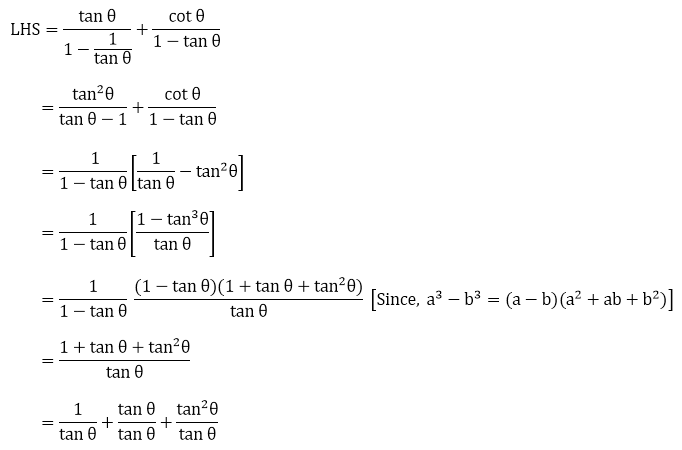
= 1 + tan θ + cot θ
= R.H.S.
– Hence, proved.
31. sec6 θ = tan6 θ + 3 tan2 θ sec2 θ + 1
Solution:
From trig. identities we have,
sec2 θ − tan2 θ = 1
On cubing both sides,
(sec2θ − tan2θ)3 = 1
sec6 θ − tan6 θ − 3sec2 θ tan2 θ(sec2 θ − tan2 θ) = 1
[Since, (a – b)3 = a3 – b3 – 3ab(a – b)]sec6 θ − tan6 θ − 3sec2 θ tan2 θ = 1
⇒ sec6 θ = tan6 θ + 3sec2 θ tan2 θ + 1
L.H.S. = R.H.S.
Hence, proved.
32. cosec6 θ = cot6 θ + 3cot2 θ cosec2 θ + 1
Solution:
From trig. identities we have,
cosec2 θ − cot2 θ = 1
On cubing both sides,
(cosec2 θ − cot2 θ)3 = 1
cosec6 θ − cot6 θ − 3cosec2 θ cot2 θ (cosec2 θ − cot2 θ) = 1
[Since, (a – b)3 = a3 – b3 – 3ab(a – b)]cosec6 θ − cot6 θ − 3cosec2 θ cot2 θ = 1
⇒ cosec6 θ = cot6 θ + 3 cosec2 θ cot2 θ + 1
L.H.S. = R.H.S.
Hence, proved.
33.

Solution:
Taking L.H.S. and using sec2 θ − tan2 θ = 1 ⇒ 1 + tan2 θ = sec2 θ

= R.H.S.
– Hence, proved.
34.

Solution:
Taking L.H.S. and using the identity sin2A + cos2A = 1, we get
sin2A = 1 − cos2A
⇒ sin2A = (1 – cos A)(1 + cos A)

Hence, proved.
35.

Solution:
We have,

Rationalising the denominator and numerator with (sec A + tan A) and using sec2 θ − tan2 θ = 1, we get

= R.H.S.
– Hence, proved.
36.

Solution:
We have,

On multiplying the numerator and denominator by (1 – cos A), we get

= R.H.S.
– Hence, proved.
37. (i)

Solution:
Taking L.H.S. and rationalising the numerator and denominator with √(1 + sin A), we get

= R.H.S.
Hence, proved.
(ii)

Solution:
Taking L.H.S. and rationalising the numerator and denominator with their respective conjugates, we get

= 2 cosec A
= R.H.S.
– Hence, proved.
38. Prove that:
(i)

Solution:
Taking L.H.S. and rationalising the numerator and denominator with their respective conjugates, we get

= 2 cosec θ
= R.H.S.
– Hence, proved.
(ii)
Solution:
Taking L.H.S. and rationalising the numerator and denominator with their respective conjugates, we get

= R.H.S.
– Hence, proved.
(iii)
Solution:
Taking L.H.S. and rationalising the numerator and denominator with their respective conjugates, we get

= 2 cosec θ
= R.H.S.
– Hence, proved.
(iv)
Solution:
Taking L.H.S., we have

= R.H.S.
– Hence, proved.
39.

Solution:
Taking LHS = (sec A – tan A)2, we have

= R.H.S.
– Hence, proved.
40.

Solution:
Taking L.H.S. and rationalising the numerator and denominator with (1 – cos A), we get

= (cosec A – cot A)2
= (cot A – cosec A)2
= R.H.S.
– Hence, proved.
41.

Solution:
Considering L.H.S. and taking L.C.M. and on simplifying, we have,

= 2 cosec A cot A = RHS
Hence, proved.
42.

Solution:
Taking LHS, we have

= cos A + sin A
= RHS
– Hence, proved.
43.

Solution:
Considering L.H.S. and taking L.C.M. and on simplifying, we have,

= 2 sec2 A
= RHS
Hence, proved.
RD Sharma Solutions for Class 10 Maths Chapter 6 Exercise 6.2 Page No: 6.54
1. If cos θ = 4/5, find all other trigonometric ratios of angle θ.
Solution:
We have,
cos θ = 4/5
And we know that,
sin θ = √(1 – cos2 θ)
⇒ sin θ = √(1 – (4/5)2)
= √(1 – (16/25))
= √[(25 – 16)/25]
= √(9/25)
= 3/5
∴ sin θ = 3/5
Since, cosec θ = 1/ sin θ
= 1/ (3/5)
⇒ cosec θ = 5/3
And, sec θ = 1/ cos θ
= 1/ (4/5)
⇒ cosec θ = 5/4
Now,
tan θ = sin θ/ cos θ
= (3/5)/ (4/5)
⇒ tan θ = 3/4
And, cot θ = 1/ tan θ
= 1/ (3/4)
⇒ cot θ = 4/3
2. If sin θ = 1/√2, find all other trigonometric ratios of angle θ.
Solution:
We have,
sin θ = 1/√2
And we know that,
cos θ = √(1 – sin2 θ)
⇒ cos θ = √(1 – (1/√2)2)
= √(1 – (1/2))
= √[(2 – 1)/2]
= √(1/2)
= 1/√2
∴ cos θ = 1/√2
Since, cosec θ = 1/ sin θ
= 1/ (1/√2)
⇒ cosec θ = √2
And, sec θ = 1/ cos θ
= 1/ (1/√2)
⇒ sec θ = √2
Now,
tan θ = sin θ/ cos θ
= (1/√2)/ (1/√2)
⇒ tan θ = 1
And, cot θ = 1/ tan θ
= 1/ (1)
⇒ cot θ = 1
3.

Solution:
Given,
tan θ = 1/√2
By using sec2 θ − tan2 θ = 1,

4.

Solution:
Given,
tan θ = 3/4
By using sec2 θ − tan2 θ = 1,

sec θ = 5/4
Since, sec θ = 1/ cos θ
⇒ cos θ = 1/ sec θ
= 1/ (5/4)
= 4/5
So,
5.

Solution:
Given, tan θ = 12/5
Since, cot θ = 1/ tan θ = 1/ (12/5) = 5/12
Now, by using cosec2 θ − cot2 θ = 1,
cosec θ = √(1 + cot2 θ)
= √(1 + (5/12)2 )
= √(1 + 25/144)
= √(169/ 25)
⇒ cosec θ = 13/5
Now, we know that
sin θ = 1/ cosec θ
= 1/ (13/5)
⇒ sin θ = 5/13
Putting the value of sin θ in the expression, we have,

= 25/ 1
= 25
6.

Solution:
Given,
cot θ = 1/√3
Using cosec2 θ − cot2 θ = 1, we can find cosec θ
cosec θ = √(1 + cot2 θ)
= √(1 + (1/√3)2)
= √(1 + (1/3)) = √((3 + 1)/3)
= √(4/3)
⇒ cosec θ = 2/√3
So, sin θ = 1/ cosec θ = 1/ (2/√3)
⇒ sin θ = √3/2
And we know that
cos θ = √(1 – sin2 θ)
= √(1 – (√3/2)2)
= √(1 – (3/4))
= √((4 – 3)/4)
= √(1/4)
⇒ cos θ = 1/2
Now, using cos θ and sin θ in the expression, we have

= 3/5
7.

Solution:
Given,
cosec A = √2
Using cosec2 A − cot2 A = 1, we find cot A

= 4/2
= 2
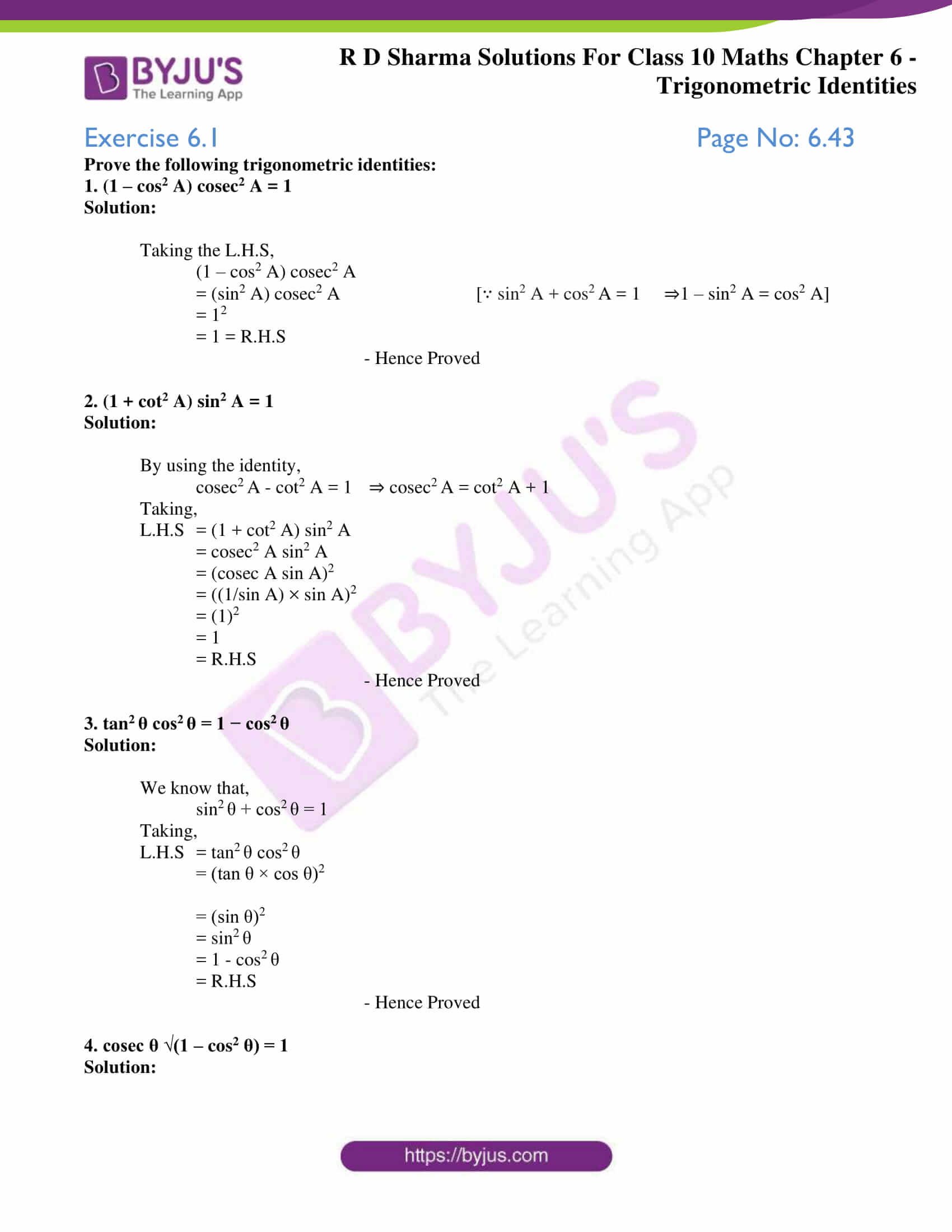
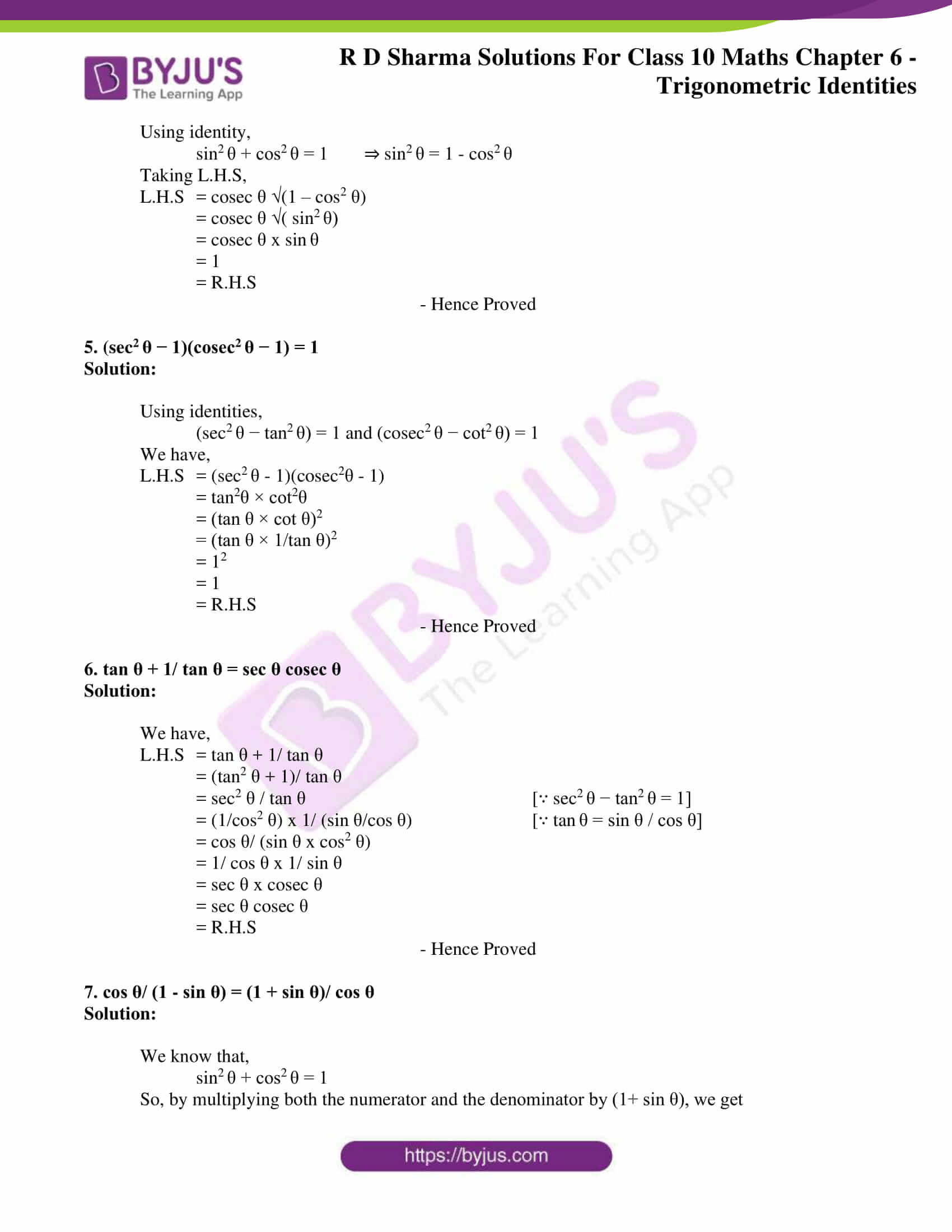





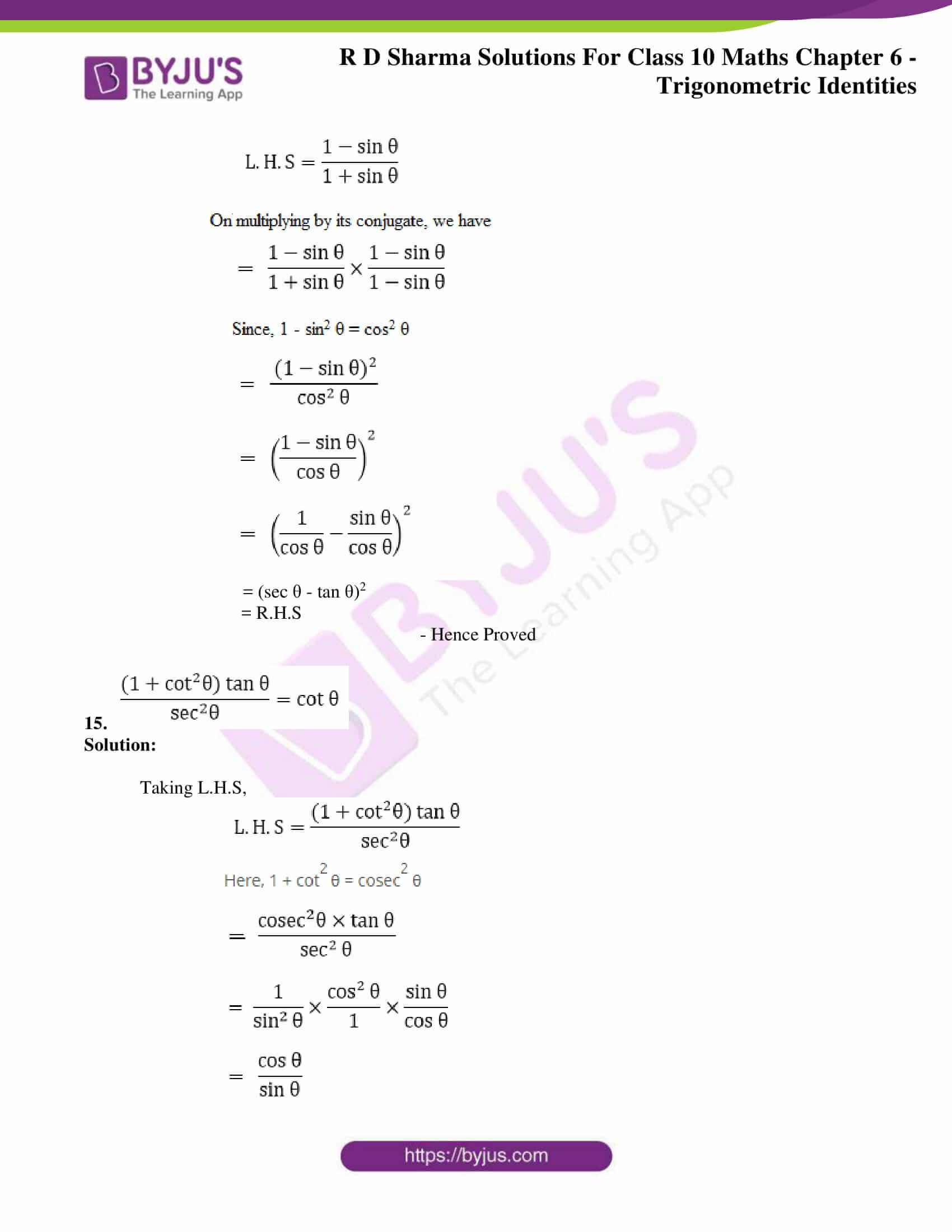

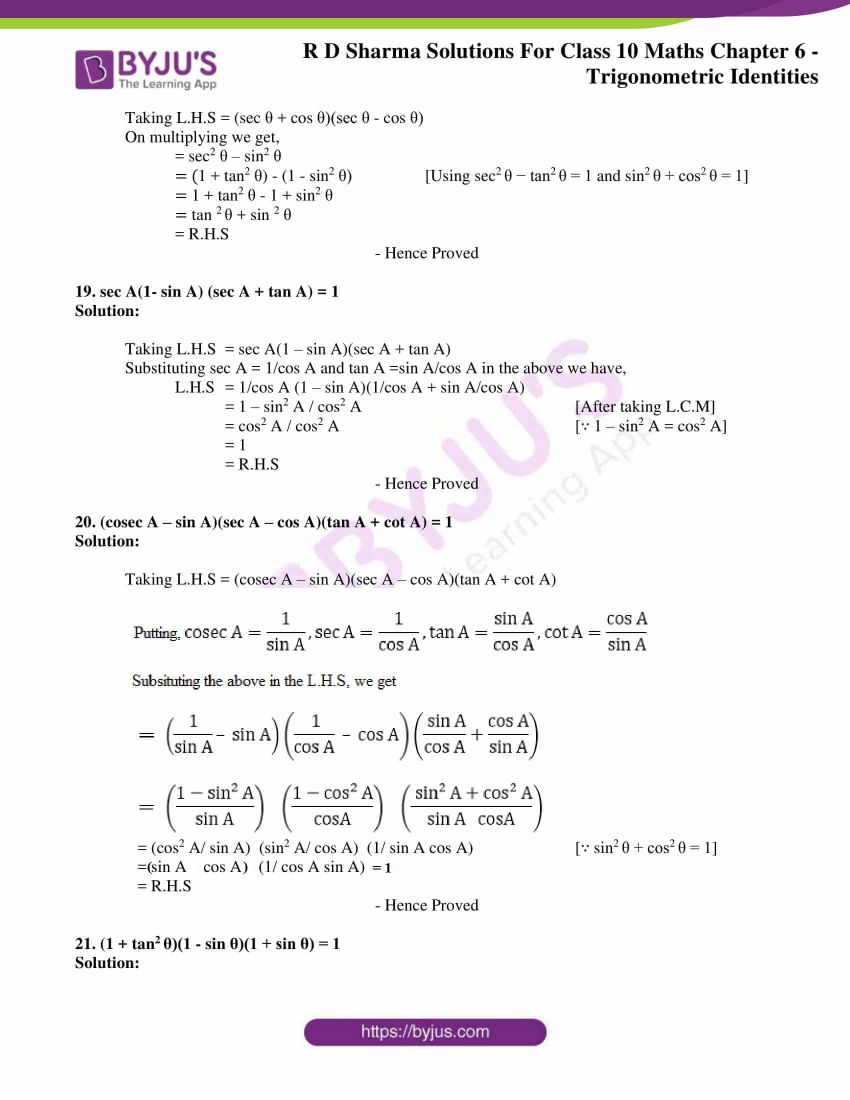
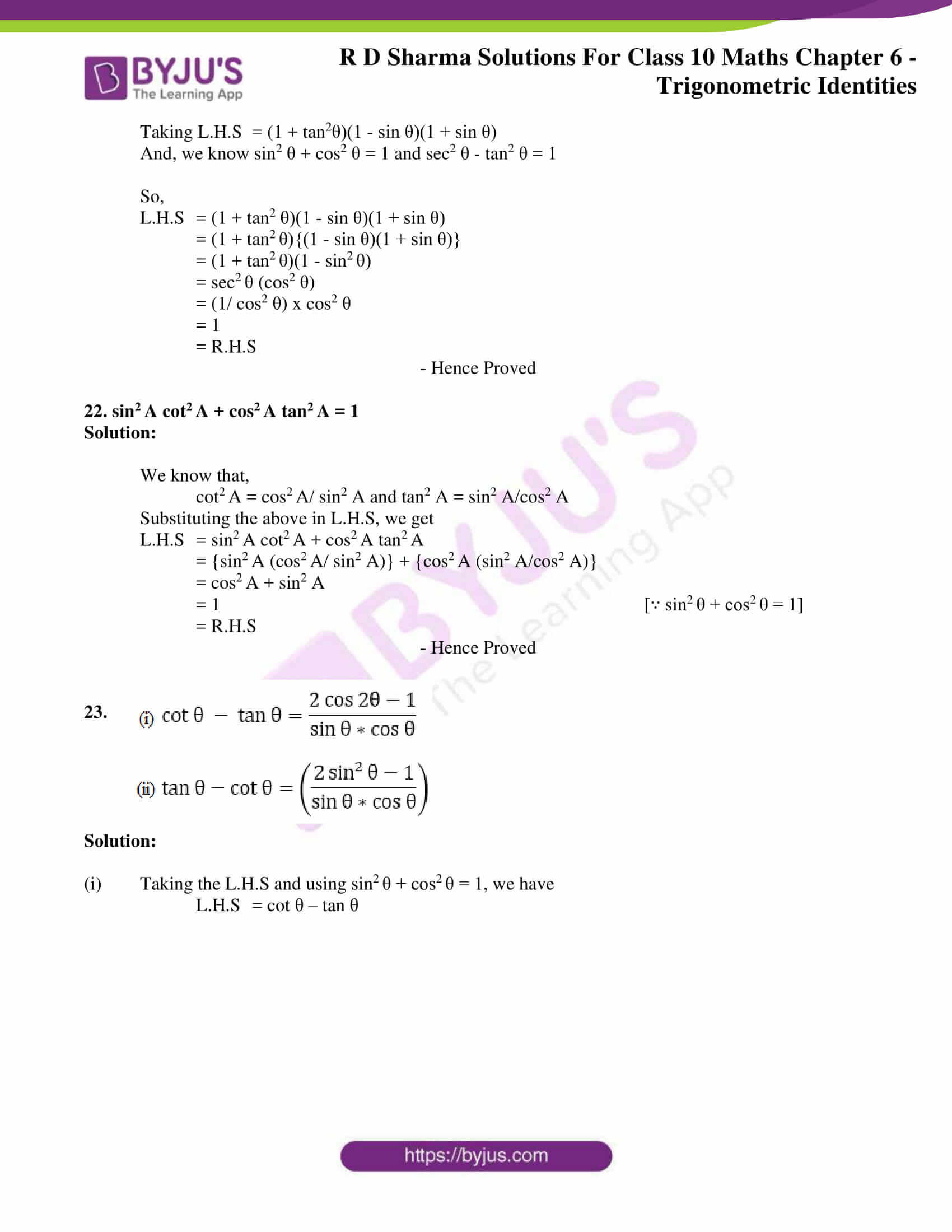



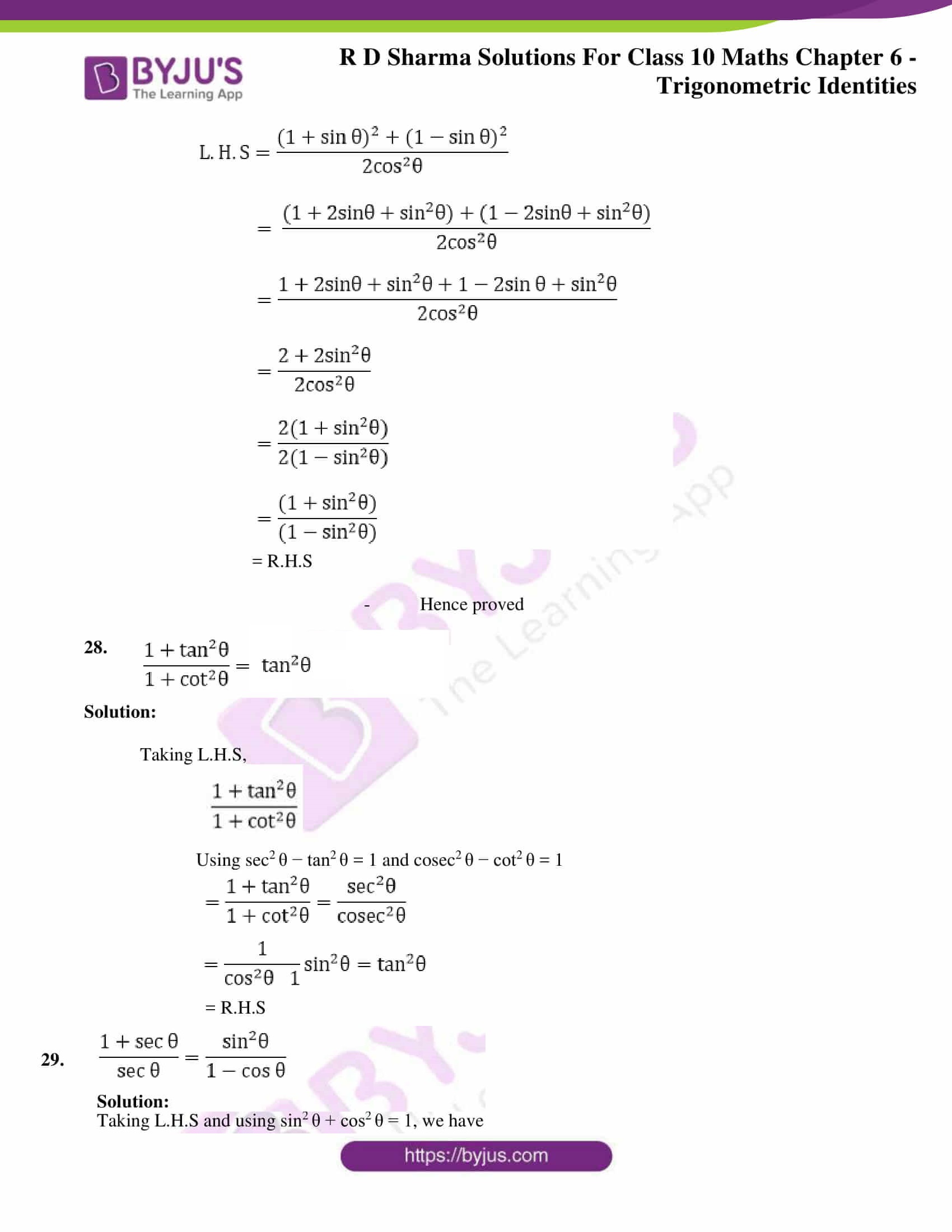






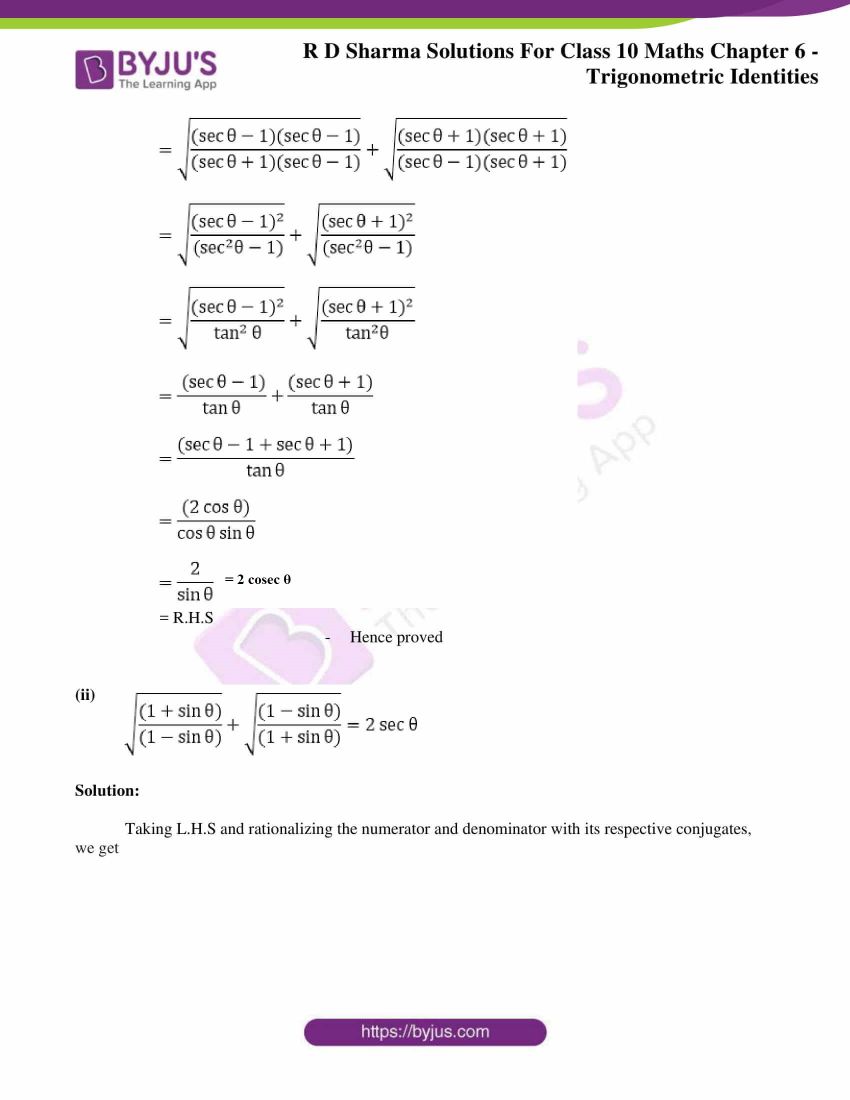




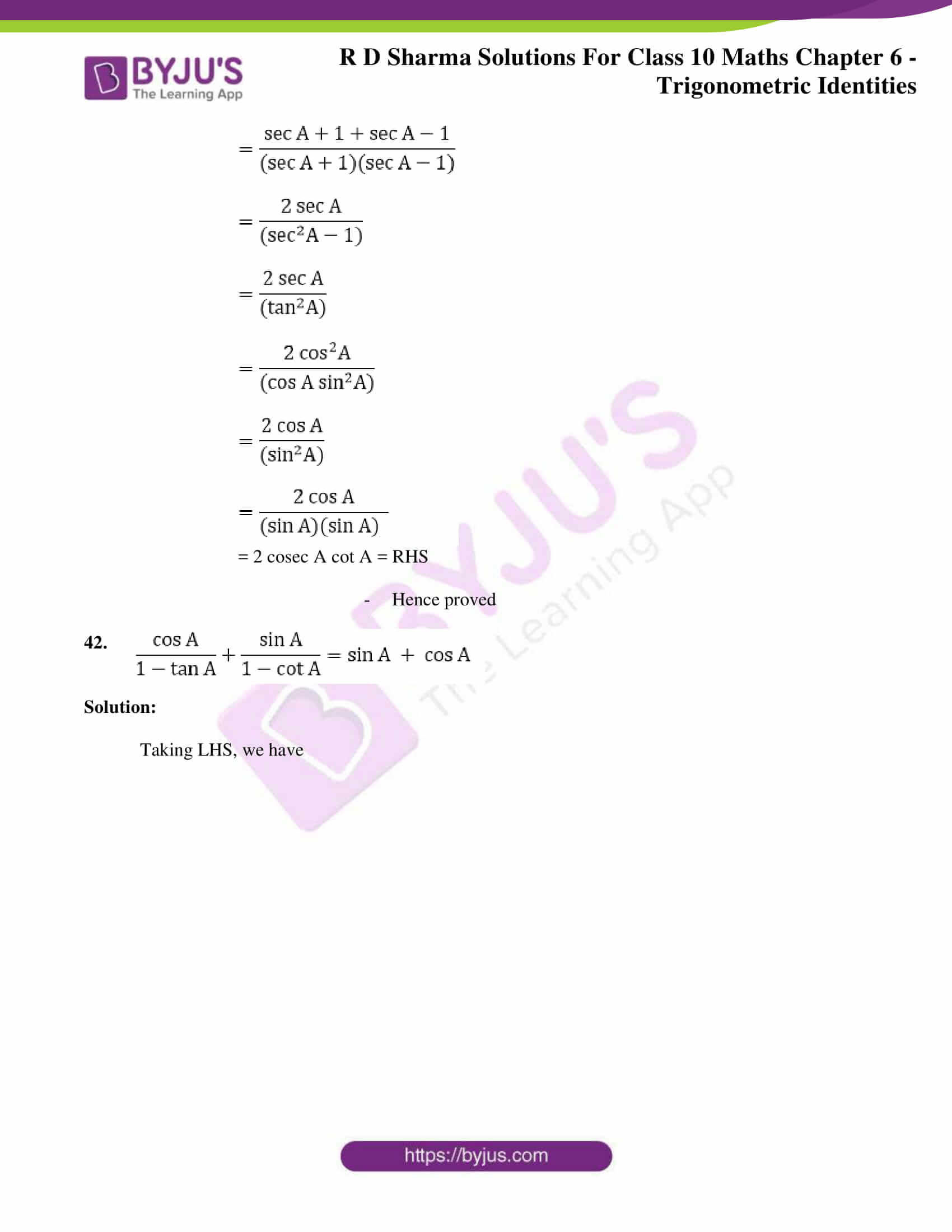







Comments